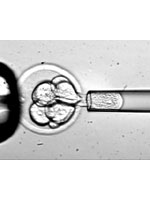WEB FOCUS
Making Stem Cells

In this focus:
Current research | Weblinks | Archive
Nature has published two new methods for deriving embryonic stem cells that aim to overcome ethical objections to using human embryos for research. But while it remains to be seen whether these particular methods will translate widely to laboratories and clinics, there is no doubt that technically innovative and elegant methodologies will propel the stem-cell field forward.
In this Web Focus, Nature highlights the two new papers and recent news coverage and opinion, as well as a sample of other technical advances in stem-cell research. Image credit: Advanced Cell Technology.
Current research
LETTER
Embryonic and extraembryonic stem cell lines derived from single mouse blastomeres Free access
Young Chung et al.
Nature advance online publication; published online
16 October 2005
doi:10.1038/nature04277
LETTER
Generation of nuclear transfer-derived pluripotent ES cells from cloned Cdx2-deficient blastocysts Free access
Alexander Meissner and Rudolf Jaenisch
Nature advance online
publication; published online 16 October 2005
doi:10.1038/nature04257
NEWS AND VIEWS
Medicine: Politic stem cells Free access
Research on embryonic stem cells holds huge promise for understanding and treating disease. Many people oppose such research on religious and ethical grounds, but two new methods may bypass some of these objections.
Irving L. Weissman
Nature advance online publication; published online 16 October 2005 doi:10.1038/nature04305
Top of pageWeb links
Top of pageArchive
News@Nature.com
'Ethical' routes to stem cells highlight political divide
Erika Check & Carina Dennis
Published online: 16 October 2005; | doi:10.1038/4371072b
EDITORIAL
Every Little Helps
Novel techniques that could help to make human embryonic stem-cell research morally acceptable will not immediately defuse the ethical debate over the work.
Nature 437, 1065 (20 October 2005) doi: 10.1038/4371065a
NEWS
Senator boosts chances of stem-cell reform
Erika Check
Nature 436, 608-609 (4 August 2005) doi:10.1038/436608a
Stem-cell 'heroes' celebrate a series of breakthroughs
Erika Check
Nature 436, 9 (7 July 2005) doi:10.1038/436009a
Gene defects plague stem-cell lines
Roxanne Khamsi
Published online: (5 September 2005) doi:10.1038/news050905-1
PROSPECT
Stemming the tide
Stem-cell policies could dictate job flow.
Paul Smaglik
Nature 437, 783 (September 2005) doi:10.1038/nj7059-783a
BRIEF COMMUNICATION
Dogs cloned from adult somatic cells
Nature 436, 641 (4 August 2005) doi:10.1038/436641a
EDITORIAL
A dog's life
The first cloned dog was born at some cost, and there needn't be
many more
Nature 436, 604 (4 August 2005) doi:10.1038/436604a
LETTER
Mismatch repair genes identified using genetic screens in Blm-deficient embryonic stem cells
Nature 429, 891-895 (24 Jun 2004)
Genome-wide phenotype analysis in ES cells by regulated disruption of Bloom's syndrome gene
Nature 429, 896-899 (24 Jun 2004)
Birth of parthenogenetic mice that can develop to adulthood
Nature 428, 860-864 (22 April 2004) doi: 10.1038/nature0240
NEWS AND VIEWS
Genomic imprinting: Mice without a father
In mammals, genomes from both parents are generally needed to make viable offspring. But changing the expression of 'imprinted' genes can render the father's contribution dispensable.
Nature 428, 809-811 (22 April 2004) doi: 10.1038/428809a
ARTICLE
Mice cloned from olfactory sensory neurons
Nature 428, 44-49 (04 Mar 2004)
Odorant receptor gene choice is reset by nuclear transfer from mouse olfactory sensory neurons
Nature 428, 393-399 (25 Mar 2004)
LETTER
Derivation of embryonic germ cells and male gametes from embryonic stem cells
Nature 427, 148-154 (08 Jan 2004)


